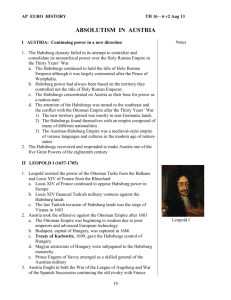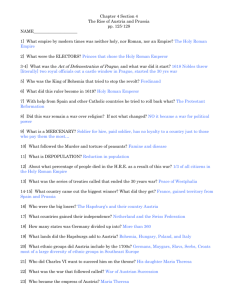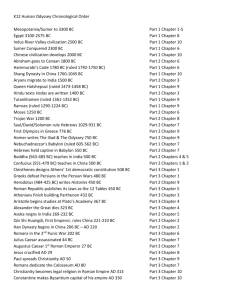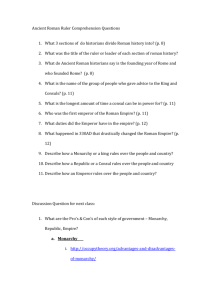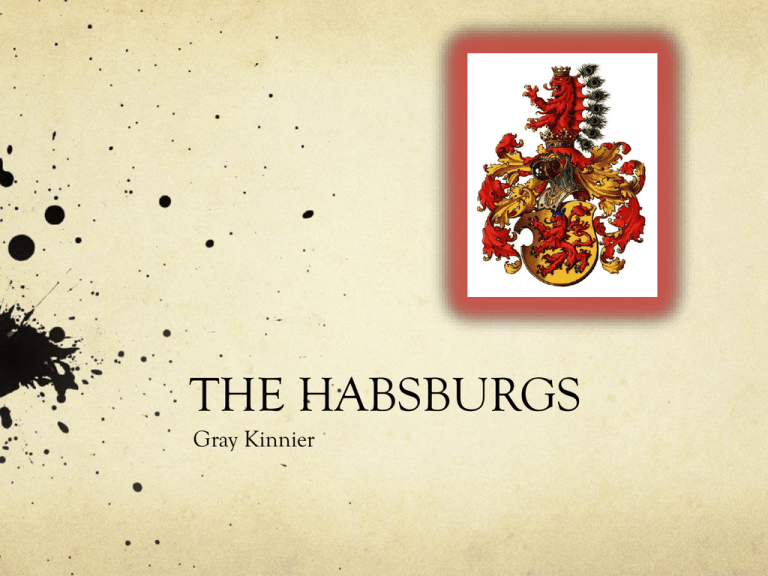
THE HABSBURGS
Gray Kinnier
The One that started it
all…was actually not a
Habsburg
The title of Holy Roman Emperor was created on
Christmas Day in the year 800 when the Pope crowned
Charles the Great as Emperor of the West
The title of Holy Roman Emperor passed through
Charles’ Carolingian descendants until Otto I rooted
his power in the German States
This loose conglomerate of the German States would
become what until its collapse in 1806 would be
known as the Holy Roman Empire, this would be the
means for the rise of Habsburg power.
The Founding of a Dynasty
Rudolf the first reigned from 1273 to 1291
He was the first Habsburg to be crowned Holy
Roman Emperor by the pope. Originally a SwissGermanic King he drew his power from the
disputed province of Alsace near the French
border.
He was granted key Austrian territories by the
pope, that would later form the center of the
Habsburg domains, but those were passed to his
sons.
An Imperial Affair
Fredrick III was an important Habsburg to rise
to the position of Holy Roman Emperor in
1453.
He was able to successfully cement his position
as the Emperor through a financially
advantageous marriage to Portugal.
His election as the Holy Roman Emperor would
begin a precedent that would hold of having a
Habsburg on the Imperial throne until its
inevitable fall.
Like Father like Son
Maximilian I was the eldest son of Holy
Roman Emperor Frederick III. He was
granted the title of Duke of Austria in his
mid-thirties.
His marriages would cause several disputes
in international politics (more on this
later…)
After ruling jointly with his father for 10
years he would be elected Holy Roman
Emperor in 1493 unifying the territorial
possessions of the family.
Neither Holy nor Roman nor
an Empire
Pause for a moment to consider what this Holy Roman
Empire was
Seven elector states would choose an emperor to “reign”
over the provinces that would today be considered Germany.
However these provinces were fairly disorganized and
autonomous.
The Habsburg however would draw their power from their
position as Holy Roman Emperor for many years until the
Peace at Westphalia would diminish that power, and they
would begin to draw the majority of their clout from their
position as the Duke of Austria.
A Marriage, An Empire that’s also not an
Empire, and some very Angry French People
Back to Max’s Marriage…
Maximilian I married Mary of Burgundy, who had
no brothers and was the heir to that throne.
This established the precedent of Habsburg
control in the low countries, which would royally
tick off the French (get it…royally…haha…)
When she died Maximilian would wed a Sforza
bride extending his influence over Northern Italy
as well
More Land = Happy Habsburg
The Habsburgs would continue to uses tools such as
marriage to add more and more territory to their
domains
It was all consolidated when Charles V, the grandson
of Ferdinand and Isabella, rose to the position of Holy
Roman Emperor in the year 1519 and would reign
until 1558
His possessions included Spain, modern-day Germany,
Belgium, Northern Italy, Austria, Naples, Milan, and
all of Spain’s associated colonies in the new world
The Possessions of Charles V
Too Much for One Man
Charles V served as a fork in the road for the Habsburg
Dynasty
His reign represented the climax of square miles under
Habsburg control, with territory on 3 continents.
However his reign was plagued by fierce opposition
from the English and the French, but most of all, as a
young emperor, the staunchly catholic Charles V had
to deal with Martin Luther and the beginning of the
Protestant Reformation
Too Much for One Man
(cont.)
Despite many attempts to quash the protestant movement, it
gained only more and more followers throughout Charles’
reign.
His empire became unwieldy and as an old emperor in 1557
he abdicated the throne and split the empire.
Spain, The Netherlands, Habsburg possessions on the
Italian peninsula, and Spanish Territory in the New World
went to his son Phillip II
The position of Holy Roman Emperor, Habsburg
possessions in Germany, Austria, and Hungary went to his
brother Ferdinand II
Charles V
A Fork in the Road
With his abdication, Charles recognized he was no longer
fit to rule, yet his son was not yet ready to control a vast
empire (nor would he ever be for that matter).
His hope was that someday Phillip might reign over the
territories his father had once commanded, however
Ferdinand was unwilling to relinquish the Austrian
throne or the Holy Roman Empire, passing them
through his own son Maximilian.
This forever split the family into the Spanish Habsburgs
and the Austrian Habsburgs
The Age of Religious Wars
Charles’ successor’s would singlehandedly destroy what
he had created, let us start with Ferdinand II.
Ferdinand II was the Holy Roman Emperor through
his position as King of Bohemia. Like all Habsburg’s
he was a staunch catholic and he began to suppress the
rights of protestants in Bohemia.
This was the spark that would begin a thirty year
conflict (1618-1648) waged by Austria, the states of the
Holy Roman Empire, France, Spain, and Sweden,
which would kill off 20% of the German population.
Thirty Years War in relation to
the Austrian Habsburgs
The wars conclusion at The Peace of Westphalia (signed by
Ferdinand III, a Habsburg, in 1648) destroyed the Holy Roman
Empire by making the independent states within it autonomous
for all intents and purposes, allowing them the right to make
treaties with foreign nations. It would also greatly weaken the
prestige of the Austrian Habsburgs and as we said before it would
end their power as Holy Roman Emperor.
The Family’s power however did not die with the Empire, it simply
moved.
The Habsburgs would remain the Holy Roman Emperor until the
fall of the Empire to Napoleon in 1806, but as this position
became more and more hollow they drew on their Austrian
territories as their political center.
Thirty Years War
Phillip II
Phillip II would become King of Spain in 1557 and
would rule until 1598.
In the early half of his reign he continued to expand in
the new world, and with his ascendance to the throne
of Portugal he controlled all of South America.
Phillip’s empire however was expensive to maintain
and more and more his empire was dependent upon
silver flowing in from the New World.
The Spanish Armada
Again, like all Habsburg’s, Philip was a staunch Catholic. He
viewed the spread of Catholicism as the overarching goal of his
life.
His anger at the Protestant English Queen, Elizabeth I, stemmed
from their religious differences, their trade war, and her refusal of
a marriage proposal after his wife Mary I (Elizabeth’s sister) died,
and he lost his position as King Consort of England.
With the execution of Mary Queen of Scots in 1588, a Catholic,
Phillip had the grounds he needed to send a fleet to invade
England.
The mighty Spanish Armada was destroyed due to poor strategy
and foul weather.
The Spanish Armada
The Fall of Spain
While Habsburg control in Spain seemed at the time to be an
undeniable power, Philip would essentially destroy it’s hegemony
over the rest of Europe.
He allowed Spain to be defeated by the English on the seas, and
their trade from the new world began to collapse.
Phillip, however, simply spent more. His various projects such as a
massive castle for himself would bankrupt Spain three times.
It was also Phillip who began the revolt in the Netherlands,
through harsh anti protestant policies. The loss of the highly
urbanized and wealthy Netherlands would not only be a blow to
the Spanish Habsburgs, but it would be the first in a long line of
nations to rebel and leave the Habsburg possessions.
And the Marriages Continue…
If anything can be said about the Habsburgs, it’s that they
were great at weddings.
Anne of Austria was made the bride of Louis XIII of France
(1615), and even though they had a poor relationship, she
was able to maintain her position as Queen of France and
gave birth to Louis XIV.
After the death of her husband Anne was made full regent
for the young Louis XIV, and supported Cardinal Mazarin,
leading to a victory during the wars of the Fronde.
Habsburg blood now flowed in the veins of the French
Monarchy.
Anne of Austria
Phillip IV
Phillip IV of Castile was king of Spain, or
technically the King of the Spain’s ( as he
was also Phillip III of Aragon).
It was under Phillip IV that the
Netherlands revolt under William the
Silent would finally succeed in 1648, and
the Habsburgs would lose control of those
territories.
This helped to cement the inevitable fall of
Spain on the European Stage.
Leopold I
Leopold I would reign from 1658 to 1705, and would be the
Holy Roman Emperor, but more importantly the Arch
Duke of Austria.
He was the first Austrian Habsburg to concentrate his power
and efforts on expanding what would become the Austrian
empire, instead of the Holy Roman Empire.
His great successes would come against the Ottoman Turk’s
as he and his son expanded Austrian territory greatly.
He would also be the arch-rival of his cousin Louis IV,
fighting him in many wars throughout the century.
Territorial Expansions
Charles II, The end of a
Dynasty
The Spanish Habsburgs would die out
with Charles II
Charles II would reign over Spain from
1661 to 1700. He was regarded as an
ineffectual leader with serious mental,
physical, and emotional problems.
His inability to produce a male heir left
the throne of Spain open for Louis XIV to
claim, which led to the War of Spanish
Succession
The War of Spanish
Succession
Charles II’s will left the throne of Spain to Louis XIV’s
grandson, since Charles had never produced an heir.
England and the Austrian Habsburgs declared war on
France. Leading to a long war where England and Austria
were the eventual victor.
The peace at Utrecht was incredibly favorable to England,
and it put a Bourbon on the throne of Spain however, no
one person could rule Spain and France at the same time.
This was the end of the Spanish Habsburgs, however Louis
XIV’s mother was Anne of Austria meaning Habsburg blood
was still on the Spanish throne.
Joseph I
Joseph I was Leopold I’s son, ascending to
the throne in 1705, and his reign was short
but prosperous.
He was the emperor of Austria when his
armies defeated Louis XIV and this
brought general prosperity to Austria.
However his reign was only six years long
as he died of Smallpox in Vienna in 1711.
Charles VI
Charles VI reigned over an incredibly large Empire spanning
the majority of Central and Eastern Europe.
He reigned from the death of his father in 1711 until 1740.
At the time of his death he had no male heir, and he passed
the Pragmatic Sanction, allowing the throne to pass to his
eldest daughter Maria Theresa.
However, the newly forming Brandenburg-Prussia ignored
this and began the war of Austrian Succession that would
plague the beginning of the reign of Maria Theresa.
Maria Theresa
Maria Theresa
Despite the Pragmatic Sanction, Prussia used a female ascension
to the Austrian throne as an excuse to begin the war of Austrian
Succession.
Frederick II of Prussia, in 1740, invaded and took over Silesia, a
northern-coal rich province of the Austrian Empire.
After a long war Maria Theresa was allowed to remain Arch
Duchess of Austria, but she could not become Holy Roman
Empress, and Prussia would retain Silesia.
Her husband however, Francis Duke of Lorraine, who she had
married out of love, was made Holy Roman Emperor, making her
the Holy Roman Empress for all intents and purposes.
Maria Theresa
Maria Theresa and Francis would have 16 children, 5
sons and 11 daughters
She would marry them to important families across
Europe
Among these children were Joseph II and Marie
Antoinette
Joseph II ruled jointly with his mother until she died
in 1780, at which point he became the Emperor.
Joseph II
Joseph II would rule jointly with his mother after the death
of his father, and in 1780 he became the Arch-Duke of
Austria in addition to his position as Holy Roman Emperor.
He, along with Catherine the Great of Russia and Frederick
II of Prussia, is considered one of the three enlightened
Absolute Monarchs
He reformed the Austrian Empire and was a major
proponent of Enlightened absolutism
He died childless in 1790, leaving the throne to his brother
Leopold II
Joseph II
The Fall of the Behemoth
After the short reign of Leopold II, Francis II came to power
in 1792.
He was the last Holy Roman Emperor.
In 1806, the Third Coalition suffered a crushing defeat at
Austerlitz to Napoleon. Francis finally dissolved the ancient
relic of feudal times and created the Austrian Empire. He
was the only Emperor to ever officially reign over both
Germany and Austria.
He would also be the first President of the German
Confederation, upon its creation in 1815.
Ferdinand I
Ferdinand I of Austria ruled from1835 to 1848.
His father, Francis II, viewed him as incapable of
leading and wrote in his will that he be heavily
controlled and influenced by Metternich.
This age of ultra conservatism thus receives its name
“The Age of Metternich”
He abdicated to his son in 1848, Franz-Josef, and with
the failed revolutions of 1848, Metternich resigned.
Franz-Josef Emperor of
Austria-Hungary
Franz-Josef Emperor of
Austria-Hungary
Franz-Josef came to power with the abdication of his father in 1848 after the Hungarian
Revolution
Franz-Josef would reign over the final demise of the Austrian Empire.
First, he would ruin his relations with Russian by failing to support them in the Crimean
War.
Second, he would lose all of his power over the Italian Peninsula as Cavour and PiedmontSardinia reunited the region.
He would have to bow to Magyar demands in 1867 and allow for the creation of AustriaHungary, the dual monarchy. This made Hungary internally autonomous.
Perhaps most importantly he would lose several wars to the Prussians and in 1871 he would
see Austria be upstaged by the new German Empire forged by Otto von Bismarck.
Finally and above all, he would take Austria into the First World War, dooming the nation.
However he would never see Austria’s eventual fate as he died in 1916.
Side note: Mexico
Maximilian I was an Austrian Habsburg noble who was
the only ever Emperor of the Second Mexican Empire
He was not recognized and his reign ended in
execution, however, he did institute some liberal
reforms.
This represents the only Habsburg colonization
attempt, although it was French backed, near it’s
eventual death.
The Assassination
Arch Duke Franz Ferdinand became the heir to the
Austrian throne through two untimely deaths
His politics were in direct conflict with Serbian
nationalists
In 1914, he and his wife were assassinated in Sarajevo,
triggering the complex system of alliances that would
start the First World War.
The Assassination
Charles I
After his 66 year reign Franz-Josef finally died at the
height of the First World War in 1916. Charles I
became his successor.
After the defeat of Austria he was no longer Emperor,
although he refused to abdicate and went into exile.
He was considered the last Habsburg Emperor of
Austria.
He continued to attempt to restore the monarchy until
his death in 1922.
A Dynasty in Exile
The Habsburgs continued to try to return to their
throne throughout the 20th century.
After the death of Charles, his wife Zita became the
figurehead of the monarchist movement.
The couple’s eldest son Otto continued to play a role
in Austrian politics before and after the war. Before the
second world war he served as an opposition figure to
Hitler. After the war, however, to gain legitimacy, he no
longer continued as a monarchist but as a politician in
a postwar world.
The End of an Era
Otto von Habsburg died in 2011, the final heir to the
most influential family in European History.
Works Cited
"Anne of Austria." The Biography Channel Website . A+E Corporate, n.d. Web. 23 Mar. 2014.
<http://www.biography.com/people/anne-of-austria-9185816>.
"Austria: History." World Geography: Understanding a Changing World. ABC-CLIO, 2014. Web. 7 Mar.
2014.
Cavendish, Richard. "Charles V's Spanish Abdication." HistoryToday. N.p., 2006. Web. 23 Mar. 2014.
<http://www.historytoday.com/richard-cavendish/charles-v’
s-spanish-abdication>.
"Charles V." When Worlds Collide: The Untold Story of the America's After Columbus. PBS, 23 Mar. 2014.
Web. 23 Mar. 2014. <http://www.pbs.org/kcet/when-worlds-collide/people/charles-v.html>.
Duffy, Michael. "Who's Who - Emperor Franz Josef I." First World War. N.p., 22 Aug. 2009. Web. 23 Mar.
2014. http://www.firstworldwar.com/bio/franzjosef.htm.
"Habsburg's in Exile - The Dynasty After 1918." The World of the Habsburgs. N.p., n.d. Web. 23 Mar. 2014.
<http://www.habsburger.net/en/stories/habsburgs-exile-dynasty-after-1918?language=de>.
"Habsburg Timeline." Timeline Index. N.p., n.d. Web. 7 Mar. 2014.
<http://timelineindex.com/content/select/1316/912,1407,1316?pageNum_rsSite=0&totalRows_rsSite=45>.
"Joseph II." The Biography Channel Website. A+E Corporate, n.d. Web. 23 Mar. 2014.
<http://www.biography.com/people/joseph-ii-9358214>.
Kagan, Donald, Steven Ozment, and Frank M. Turner. The Western Heritage. 9th ed. Upper Saddle River,
NJ: Pearson Prentice Hall, 2007. Print.
"Maria Theresa." The Biography Channel Website. N.p., n.d. Web. 23 Mar. 2014.
http://www.biography.com/people/maria-theresa-9398965?page=2.
Moran, Lee. "End of a Royal Dynasty as Otto von Habsburg is Laid to rest...with his heart buried in a crypt
85 miles away." The Daily Mail. N.p., 18 July 2011. Web. 23 Mar. 2014.
<http://www.dailymail.co.uk/news/article-2015994/End-Royal-dynasty-Otto-von-Habsburg-laid-rest--heartburied-crypt-85-miles-away-different-country.html>.
"Philip II." When World's Collide: The Untold Story of the America's After Colombus. PBS, n.d. Web. 23
Mar. 2014. <http://www.pbs.org/kcet/when-worldsSommervile, J P. "Austria in the Late 17th Century." Wisconsin University. Wisconsin University, n.d. Web.
23 Mar. 2014. <http://faculty.history.wisc.edu/sommerville/351/351-15.htm>.
"The Holy Roman Empire and the Habsburgs, 1400-1600." The Metropolitan Museum of Art. The
Metropolitan Museum of Art, n.d. Web. 6 Mar. 2014.
<http://www.metmuseum.org/toah/hd/habs/hd_habs.htm#thumbnails>.
The Spanish Succession." The Spanish Succession. N.p., n.d. Web. 23 Mar. 2014.
<http://www.spanishsuccession.nl>.
"Thirty Years' War." History Channel. History Channel, n.d. Web. 23 Mar. 2014.
<http://www.history.com/topics/thirty-years-war>.
Works Cited (Images)
Banner of the Holy Roman Empire as used from 1400 to 1806. Wikimedia Commons. Web. 7 Mar. 2014.
<http://commons.wikimedia.org/wiki/File:Flag-Holy-Roman-Empire.png>.
Carrero, Juan. Portrait of King Charles II of Spain. Christies, London. Christies. Web. 24 Mar. 2014.
<http://www.christies.com/lotfinder/paintings/juan-carreno-de-miranda-aviles-1614-1685-madrid-5175862details.aspx>.
Durer, Albrecht. Portrait of Maximilian I. 1519. Kunsthistorisches Museum, Vienna. Wikimedia Commons.
Web. 1 Jan. <http://en.wikipedia.org/wiki/File:Albrecht_Dürer_-_Portrait_of_Maximilian_I__Google_Art_Project.jpg>.
Ferrer-Dalmau, Augusta. The Battle of Rocroi. Wikimedia Commons. Web. 24 Mar. 2014.
<http://commons.wikimedia.org/wiki/File:Batalla_de_rocroi_por_Augusto_Ferrer-Dalmau.jpg>.
Gehrard Stroehl, Hugo. Habsburg Coat of Arms. Wikimedia Commons. Web. 7 Mar. 2014.
<http://en.wikipedia.org/wiki/File:Familienwappen_Habsburg-Stroehl.jpg>.
Habsburg Expansion 1683 - 1718. Austria in the Late 17th Century. Web. 24 Mar. 2014.
<http://faculty.history.wisc.edu/sommerville/351/351-15.htm>.
Murder of Franz Ferdinand. Smithsonian Magazine. Web. 24 Mar. 2014.
<http://blogs.smithsonianmag.com/history/2013/04/curses-archduke-franz-ferdinand-and-his-astoundingdeath-car/sarajevo-murder/>.
Portrait of Franz Josef. The First World War . Web. 24 Mar. 2014.
<http://www.firstworldwar.com/bio/franzjosef.htm>.
Reuben, Peter Paul. Anne of Austria. Wikimedia Commons. Web. 23 Mar. 2014.
<http://upload.wikimedia.org/wikipedia/commons/b/bd/Peter_Paul_Rubens__Portrait_of_Anne_of_Austria_-_WGA20365.jpg>.
Rudolf of Habsburg Monument. 2005. Speyer Cathedral, Speyer Germany. Wikimedia Commons. Web. 7
Mar. 2014.
Ter Borch, Gerard. Ratification of the Peace of Munster between Spain and the Dutch Republic in the town
hall of Munster, 15 May 1648. Rijksmuseum, Amsterdam. Wikimedia Commons. Web. 7 Mar. 2014.
<http://en.wikipedia.org/wiki/File:The_Ratification_of_the_Treaty_of_Munster,_Gerard_Ter_Borch_(1648).
jpg>.
Titian, . Portrait of Charles V. 1548. HistoryToday. Web. 23 Mar. 2014.
<http://www.historytoday.com/richard-cavendish/charles-v’
s-spanish-abdication>.
Unknown, . Joseph I Holy Roman Emperor. Schönbrunn Palace. Wikimedia Commons. Web. 24 Mar. 2014.
<http://commons.wikimedia.org/wiki/File:Joseph_I_Holy_Roman_Emperor_002.jpg>.
Van Meytens, Martin. Maria Theresa. 1759. Academy of Fine Arts Vienna. Wikimedia Commons. Web. 24
Mar. 2013. http://en.wikipedia.org/wiki/File:Kaiserin_Maria_Theresia_(HRR).jpg.
Velasquez, Diego. Portrait of Phillip IV. 1556. National Gallery, Washington D.C.. Wikimedia Commons.
Web. 24 Mar. 2014. <http://en.wikipedia.org/wiki/File:Philip_IV_of_Spain.jpg>.
Von Maron, Anton. Portrait of Joseph II, Holy Roman Emperor. 1775. Krunsthistorisches Museum.
Wikimedia Commons. Web. 24 Mar. 2014. <http://en.wikipedia.org/wiki/File:Anton_von_Maron_006.png>.

